Chocolate is so related to Valentine’s Day its time to know more about this amazing fruit!
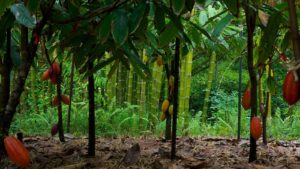
What exactly is chocolate? Chocolate comes from the Cocoa tree, which is a tropical evergreen that thrives 20 degrees north and south of the equator. There are three main varietals of cocoa trees, the Criollo which is delicious, rare and hard to grow, the Forastero, most common and versatile to grow and Trinitario, a natural hybrid from cross-pollination.
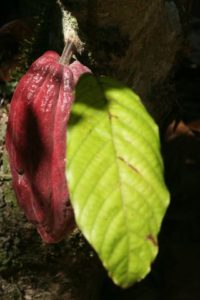
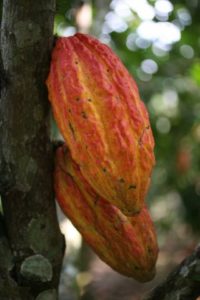
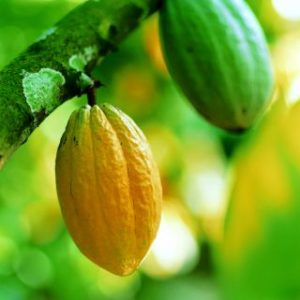
Where did chocolate originate from? Cocoa has been identified as a beverage from 2000 B.C., in a village of the Ulua Valley of Honduras. From 200 to 900 AD, cocoa was a main agricultural product of the Mayan civilization, used as currency, gifts, in religious ceremonies, and as medical treatments for over 150 ailments. The Cocoa tree was named by the Mayan-Aztek as Theobroma cocoa meaning “cocoa, food of the gods”. Not only were the fruit pods used for chocolate but the bark, flowers, wood pulp and even leaves were utilized.
How did chocolate get from the jungle to our table? Cocoa traveled to Spain and Europe in 1505 growing in demand for its medicinal properties through the 18th century. Popularity as a food was supported by the industrial age of manufacturing. Van Houten, a Dutch chemist in 1815, added alkaline salts which reduced the bitterness and a pressing procedure to remove half the cocoa butter making Dutch cocoa more consistent and affordable to the masses. Fry in 1847 is credited with adding back the melted cocoa butter thus making the chocolate moldable into bars. In 1875 Peter invented milk chocolate using Nestle’s new powdered milk. The smooth chocolate texture we know today was created by the invention of conching by Lindt. Hersey came onto the chocolate scene in 1893 with milk chocolates for the masses.
Is chocolate truly a “food of the gods” in healthy attributes? Dark Chocolate is rich in polyphenol flavonoids, more than red wine, which is beneficial to your health.
How is chocolate made? The cocoa pods are harvested by hand mainly in May and December. The cocoa pods are broken open to release the beans and piled together in heap or into a large wooden box to allow the micro-organisms to develop and initiate the fermentation of the sugar-rich pulp surrounding the beans.
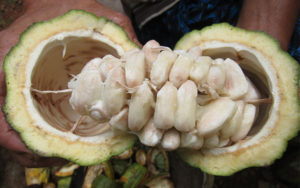
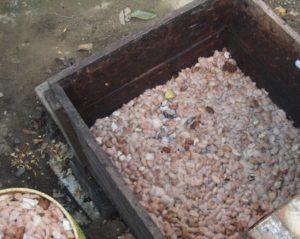
During the process, the beans are stirred to encourage even fermentation and to allow excess liquids to drain away. This takes up to three days for Criollo beans and up to six days for Forastero beans, of course depending on temperature, moisture, and the micro bugs. This fermentation ultimately breaks down the bean cell wall, releasing complex chemical changes, enzymatic reactions and the breakdown of the proteins into amino acids, resulting in the chocolate flavor, color, and polyphenol flavonoid development. The fermentation of cocoa is just as important in chocolate as the fermentation process is to convert grape juice into fine wine. After fermentation, the beans continue to oxidize while being dried in the sun.

The fermented beans are roasted, shells separated, inner nibs ground then pressed to releases the cocoa butter. The blend of sugar, cocoa liquor, and butter are conched with powerful rollers to grind the particle size down to a silky smoothness.
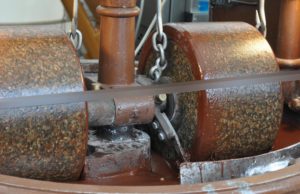

The grades or types of chocolate based on proportions of ingredients:
Chocolate Chart
Chocolate Sugar Chocolate Added Cocoa
Type Liquor Butter
Sweet 70%. 15%. 15%
Bittersweet 50% 35%. 15%
Extra Bittersweet 35%. 50%. 15%
Bitter 0% 95% 5%
Amazing insect facts in chocolate:
Midges, tiny flies about the size as a speck of dust, are responsible for pollinating the cocoa flowers to produce the fruit. these midges have a big unfinished job as the pollinated flowers are 1 in 20!
The Drosophila melanogaster or vinegar-fly is credited with the introduction of important micro-organisms and yeasts into the cocoa fermentation process.
CHOCOLATE TASTING
Chocolate tasting has now come of age, inspired by the elaborate descriptions used to describe the flavors in a wine. This new tasting ritual opens the exploration of the depth and richness of the chocolate taste. Chocolate contains over 20,000 identifiable chemical compounds which makes it one of the most complex tasting foods. A new sensory language organized in a chocolate flavor wheel allows the exploration of the intricate chocolate flavors with a vocabulary to express the taste nuances.
The Chocolate Sensory Wheel has 87 descriptors covering flavor, texture, and aroma of chocolate. The tasting utilizes the five senses of sight, touch, hearing, smell and finally taste.

This new chocolate sensory language is based on a new book “Hidden Persuaders in Cocoa and Chocolate” written by the scientists from Barry Callebaut and Givaudan.
Getting hungry…..this cake is easy and perfect for your Valentine!
Pressed Chocolate Cake – Rich Chocolate Cake without flour getting in the way
What no flour? The flourless cake is made simply with chocolate, butter, eggs, sugar, and cocoa powder. The cake is held together by the protein structure of the eggs, with just a little help from the chocolate’s starches.
What makes it rise? The cake will rise when baked because of the enlarging of the air pockets formed in the mixing. Once the cake is removed from the oven, it will fall if left to its own devices, or it may be pressed to remove the air evenly to make the silkiest texture.
Pressed Dark Chocolate Cake
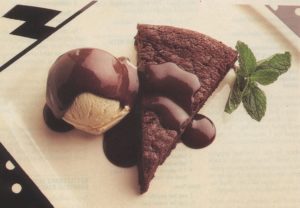
Makes 8 to 10 servings
7 ounces extra-bittersweet Chocolate such as Guittard Nocturn
14 tablespoons unsalted butter (1-3/4 sticks)
5 eggs, separated
1 tablespoon vanilla extract
¾ cup turbinado sugar
2 tablespoons unsweetened cocoa powder
Pinch salt
Ice Cream as you may enjoy
Salted Chocolate Sauce
Position rack in lower third of the oven and preheat to 350 degrees F. Butter 10 inch diameter springform pan with 3 inch high sides. Melt chocolate and butter in double boiler over gently simmering water; stir until smooth. Transfer to a medium bowl. Whisk in egg yolks and vanilla extract. Add sugar; sift in cocoa powder and whisk to blend.
Using an electric mixer, beat the egg whites with salt to soft peaks. Fold ½ into the chocolate mixture to lighten. Gently fold in the remaining whites. Pour into the prepared pan. Bake until the sides are set but the center is still moist about 30 minutes.
Set cake on rack. Loosen springform pan sides but do not remove. Top the cake with plate pressing down gently to deflate the cake, then remove plate and springform pan sides.
To serve cut the cake into wedges. Top with ice cream and sauce.
Jimmy Schmidt